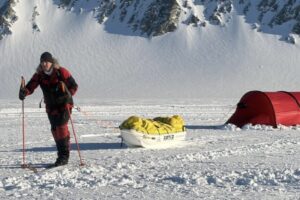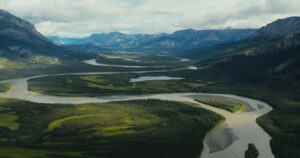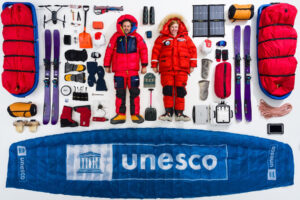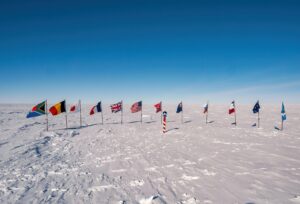Want to visit the poles? This North Pole vs South Pole comparison lays out the basics of expedition planning and more.
The Geographic North and South Poles lie where the earth’s axis of rotation intersects with its surface. But the similarity ends there. The South Pole is in the heart of Antarctica, atop a giant ice sheet resting on land. It’s cold, high, but terra firma. The North Pole, meanwhile, sits in the middle of an imperfectly frozen ocean. As we will see, this makes it much harder to travel across. It is one reason why North Pole expeditions are harder than South Pole expeditions.
Geographic vs Magnetic North Pole

The Geographic Poles are not the same places as the Magnetic Poles. The Geographic Poles are the imaginary points around which the earth spins. The Magnetic Poles are wandering locations where the earth’s magnetic field goes vertically down into the planet. Magnetic field lines cover the globe and converge on the magnetic poles. Our compass needles align with these field lines.
In the 1980s and 1990s, when contemporary North Pole expeditions were gaining popularity, skiers planning an expedition to the Geographic Pole often did a shakedown trip to the much easier Magnetic North Pole. At the time, the Magnetic Pole lay about 600km north of the Canadian arctic hamlet of Resolute. The straightforward route over solid sea ice allowed expeditions to test their equipment in the cold.
Since then, the Magnetic North Pole has gone on a tear across the Arctic Ocean toward the Russian side. It is no longer easy to get to. No one tries to ski there anymore. But occasionally, some adventurers still trek to the former site of the Magnetic Pole near Resolute and call it an expedition to the Magnetic Pole.
No one skis to the Magnetic South Pole for the simple reason that it is not even on the continent of Antarctica. It is off the coast, on the Australian side of Antarctica.
North Pole History
While the South Pole yielded to one of the first expeditions that attempted it, the North Pole was a more daunting challenge for past explorers. Because of the thick patches of ice, even in summer, seafaring vessels couldn’t reach it until the era of nuclear submarines and nuclear-powered icebreakers. Nineteenth-century explorers vied instead for what they called Farthest North: who could get closest to the Pole. The British, Americans, and Norwegians traded preeminence: the British in 1876, the Americans in 1882, the Norwegians in 1895, then the Americans again.
Frederick Cook and Robert Peary claimed to have reached the North Pole itself in 1908 and 1909 respectively, but historians now agree that both fell considerably short — and that both knew it.
In 1911, Roald Amundsen abandoned his own North Pole ambitions because he believed that the North Pole had already fallen to Robert Peary. Instead, he turned his sights on the South Pole, which he famously reached. Ironically, 15 years later, in 1926, Amundsen unknowingly also became the first to reach the North Pole. He flew over it in an airship but didn’t land.

The airship Norge in its hangar before the Amundsen-Ellsworth Transpolar Flight. Photo: Shutterstock
The first over-ice journey to the North Pole only occurred in 1968. A Minnesota insurance salesman, Ralph Plaisted, and partners Walt Pederson, Gerry Pitzl, and Jean Luc Bombardier snowmobiled there from northern Ellesmere Island. A year later, Wally Herbert led a team on foot to the Pole, using sled dogs and many airdrops.
In 1979, a Soviet team under Dmitri Shparo made the first ski trip to the Pole, starting from Siberia. The first actual round trip did not occur until 1995 when Richard Weber and Misha Malakhov did so unsupported. No one has even attempted this formidable journey again.

Ralph Plaisted’s 1968 expedition deals with some of the pressure ice off northern Ellesmere Island. Photo: Ralph Plaisted
South Pole History
Antarctica was first sighted in 1820, either by Thaddeus von Bellingshausen on a Russian expedition or by Edward Bransfield during a British mapping survey. But it wasn’t until the early 20th century that the heroic age of Antarctic exploration began.
Norwegian Carsten Borchgrevink led the first expedition using dogs and sleds. In 1902, Robert Scott, Ernest Shackleton, and EA Wilson pushed to within 660km of the South Pole. A Shackleton-led team came even closer in 1909, turning around just 179.6km from their target and narrowly surviving the return journey.

Ernest Shackleton, Robert Scott, and Edward Wilson before their 1902 march to the South Pole. Photo: Wikimedia Commons
In 1910, Amundsen and Scott set off independently for the South Pole in that tragic race. Amundsen, using dogs and skis, reached it several weeks ahead of Scott in 1911. Scott’s expedition also reached the Pole, but he and his men died on the return journey, succumbing to hunger and cold just 17km from a food depot.
Modern North Pole expeditions
Historically, North Pole trips began from northern Ellesmere Island. From here, roughly 83˚06′, it’s about 767km to the Pole. No one uses northern Greenland as a starting point because the strong current pushes you not just south but eastward toward open water.
Despite this tradition, the route from Ellesmere Island has several disadvantages. First, as ocean currents press the moving pack ice against the continental shelf off Ellesmere Island, the ice buckles into towering barriers sometimes 20m high. Many expeditioners have injured themselves trying to horse their fully laden sleds over these obstacles in the first few days. Others just gave up in frustration. Sometimes, it takes almost a week of incredibly taxing work, advancing just a kilometre or two a day, to pass beyond this zone to smoother ice.

Mike Horn drags his sleds over buckled ice. Photo: Borge Ousland
Skiers then must contend with the ocean currents conspiring against them. It’s like moving up a down escalator. While you trek, and especially while you sleep, the drifting ice carries you back toward your starting point.
Launching from Russia avoids these issues because you are going with the current and the loose sea ice has not buckled into gigantic ridges. But the Russian side presents another difficulty: open water and dangerously thin ice for the first 50km. In 2004, Dominick Arduin, attempting to be the first female soloist to the Pole, disappeared in that area, presumably drowned.
Once you get across that section, it’s much easier, but full North Pole expeditions traditionally begin from land. Hopscotching by plane over those risky first kilometres to solid ice lessens the status of one’s expedition compared to those who have managed to do the whole trek.
Getting around leads
Regardless of the starting point, all North Pole expeditions have to contend with leads — long cracks of open water, caused by currents, storms, or tides, that are too wide to jump. Some are hundreds of metres across.
There are various strategies around leads. One, you can detour around them — easier in an era when your home team can access satellite imagery and tell you which way to go and how long the detour will take. Two, early in the season, when it’s very cold, you can wait in place for a day or two until the lead refreezes.

Swimming across a lead in a special drysuit. Photo: Borge Ousland
Three, you can paddle across the lead. Some expeditions carry sleds that can double as boats. Others use packrafts and float the sleds behind them. Finally, in the 1990s, Borge Ousland started using a custom-made drysuit that slips over ski clothing. He then swam across the lead, pulling his floating sled behind him. For many North Pole expeditions, this became the preferred method.
North Pole expeditions can take place year-round but almost all begin in February-March. At this time of year, the sun is just returning and there are only a handful of hours of daylight. This marks another significant difference between North and South Pole expeditions. South Pole expeditions take place during the height of the Antarctic summer. It’s bright 24 hours a day.
While it’s cold on the high Antarctic plateau (average temps at the South Pole in midsummer/December are -26˚ to -30˚C), that is balmy compared to starting temperatures for North Pole expeditions. Skiers on northern Ellesmere have experienced -58˚C. The difference between -30˚ and -50˚ may not seem important — both are frigid — but -30˚ is vastly easier to live in. Sleds pull more easily, stoves are less cranky, equipment breaks down less, and it’s much gentler on the body.

Crossing a lead during the polar night by packraft. Photo: Borge Ousland
There have only been three North Pole winter expeditions. Skiing the entire way in the dark, on a surface where you can fall through thin ice at any time, is psychologically and practically at another level. Because of logistics, no one does South Pole winter expeditions, at least so far. Antarctic Logistics and Expeditions, the company that brings adventurers to Antarctica, only flies during the austral summer.
Polar bears are a real threat on full North Pole expeditions. Though rare on the Arctic Ocean compared to some other areas, they can show up anywhere and have troubled several North Pole travelers in the past. A firearm and other deterrents are essential. Though not naturally aggressive toward humans, a polar bear’s curiosity may become destructive or dangerous, especially if it happens upon a camp while adventurers are sleeping. Antarctic Emperor Penguins aren’t quite as troublesome…
Full North Pole expeditions have become rarer, as the sea ice thins due to climate change. A lot of the hard stuff has already been done, and the few which haven’t — such as solo unsupported to the North Pole and back to land, or solo unsupported from Russia to Canada via the North Pole — are too hard for the current crop of adventurers. Many of them are not committed polar travelers but athletes who want success and notoriety quickly. They tend to focus on doing slightly new angles along much easier South Pole routes. The North Pole takes more than fitness; it requires experience with that unique surface.
Another reason why full North Pole expeditions have all but vanished in recent years is a logistical one. The Canadian arctic charter airline, Kenn Borek Air, used to drop expeditions off on northern Ellesmere Island and pick them up at the North Pole or partway there if they gave up. It cost a small fortune, even more than Antarctica, but it made expeditions possible.
But some slow, poorly organized expeditions tried to continue too far into spring and coerce the pilots to land on dangerous ice. The two charter aircraft sitting at the bottom of the ocean from earlier times attest to the dangers of this practice. Nowadays, you can still hire the airline to drop you on northern Ellesmere Island, though pilots will not fly until the sun returns in early March. Ideally, you want to leave earlier than that. But because of these past issues, they are reluctant to pick up an expedition unless it finishes preternaturally fast.
The only other way home from the Pole is via an aircraft from the Russian ice station Barneo. But Barneo only runs for about three weeks in early April. Since expeditions can only begin on Ellesmere in early March, only the swiftest can cover the 767km in time. There hasn’t been a full North Pole expedition since 2014 when guides Eric Larsen and Ryan Waters skied there unsupported.
Modern South Pole Expeditions
Human-powered expeditions, whether on foot, kiting on skis, or by bicycle, are so common at the South Pole that a huge tourism industry has sprung up. The South Pole itself has a large station staffed year-round by scientists. For adventure tourists, a private camp opens at Union Glacier every year between November and February, throughout the Antarctic summer.

A cruise ship takes tourists along the Antarctic coastline. Photo: Shutterstock
Antarctica even has a major “road”, the South Pole Overland Traverse (SPOT), that runs 1,601km from the American McMurdo research station to the South Pole. This major landmark can make navigation a breeze.
There are a variety of starting points for expeditions, some of which begin on the sea ice, some from the continent’s edge. All require logistical support from Antarctic Logistics and Expeditions.
Based on the skiers’ experience, ALE decides which routes an expedition may follow. Novice or relatively new travelers must follow well-worn paths from, for example, Hercules Inlet to the South Pole. Veteran polar travelers may choose their own way. They then contend with crevasses and far more difficult scenarios in emergencies. Most Antarctic expeditions follow the standard routes.
Antarctica is no walk in the park, but these expeditions typically have fewer concerns than those in the far north. You can ski without fear of falling through the ice into the icy water. While crevasses can present a danger in off-route Antarctica, the paths that many skiers take to the South Pole are well-known and safe, and evacuation can be relatively straightforward.
Antarctica, however, is much windier than the Arctic. Sastrugi, or hard snow waves carved by the wind, can be much bigger in Antarctica, occasionally with troughs a metre deep. But this is uncommon. Usually, sastrugi are just bumpy and make travel a little slower.

Off-route Antarctica. Crevasse on the 1957-8 Trans-Antarctic Expedition.
Last Degrees, Crossings, and Polar Journey Definitions
In 2021, for the third year in a row, even the one- and two-week tours failed to reach the North Pole. COVID caused the last two cancellations. The 2019 season was aborted because of geopolitical tensions between Russia and Ukraine, played out over a Ukrainian plane and the Russian polar base Barneo.
Barneo is set up every spring on a stable patch of sea ice roughly 100km from the Pole. Although full North Pole expeditions have used it, its raison d’être is to host last-degree skiers, marathon runners, and champagne tourists who want just a sampling of the top of the world.
All Antarctic expeditions were likewise canceled in 2020. The status of the 2021 season remains unclear. Although Antarctica was the last continent to register infections, 36 people at a Chilean base tested positive in December.
Last-degree trips do exactly what they say on the tin: You travel the final degree of latitude to 90°N or 90˚S. It takes six or seven days, plus travel time to and from the starting point. Russians call this “extreme tourism”, and it is at least that.
Polar definitions have been quite the can of worms. Fortunately, the formation of PECs (The Polar Expeditions Classification Scheme) has cleared up these ambiguities considerably. You can head to their website for clear definitions explaining solo expeditions, or what qualifies as unsupported.

A map showing the 10 most common starting points for Antarctic expeditions. 1. Hercules Inlet 2. Messner Start 3. Ross Island 4.Berkner Island 5.Patriot Hills 6. Novo 7. Axel Heiberg Glacier 8. Bay of Whales 9. Leverett Glacier 10. Larsen Ice Shelf. Photo: Eric Philips/Icetrek
North Pole vs South Pole: Costs
The North and South Poles have one other thing in common, besides their frigidity: cost. Whether you aim north or south, neither of these endeavors is for the faint of wallet. Even a 10-day, last-degree trek to the North Pole costs around $60,000. A guided, full-length expedition to the South Pole is about $75,000. Independent journeys may be more or less expensive, depending on route, number of airdrops, etc. but can easily pass $100,000.






